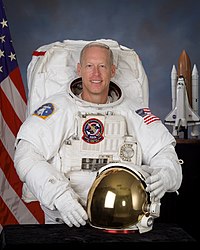Patrick G. Forrester
| Patrick Forrester | |
|---|---|

|
|
| Country: | United States |
| Organization: | NASA |
| selected on | May 1, 1996 ( 16th NASA Group ) |
| Calls: | 3 space flights |
| Start of the first space flight: |
August 10, 2001 |
| Landing of the last space flight: |
September 12, 2009 |
| Time in space: | 39d 14h 18min |
| EVA inserts: | 4th |
| EVA total duration: | 25h 30m |
| retired on | August 2011 |
| Space flights | |
Patrick Graham "Pat" Forrester (born March 31, 1957 in El Paso , Texas , USA ) is a former American astronaut and former colonel in the US Army .
Life
Born in Texas, Forrester grew up in the small town of Springfield , Virginia , about 12 miles southwest of the capital Washington, DC . In 1975 he graduated from West Springfield High School and joined the US Army . This paid him for his studies at the renowned United States Military Academy in West Point ( New York ). He studied applied natural and engineering sciences and received a bachelor's degree in 1979 .
After Forrester West Point had left, he settled in Fort Rucker ( Alabama trained as pilots). He received his license in September 1980 and stayed at the Army Aviation School to train his own cadets. He was also the personal assistant to the Fort Rucker Vice Commander. In 1984 he was transferred to the United States Army Garrison in Hawaii . In the 25th Infantry Division he served, among other things, as a column leader and flight operations manager.
Forrester then returned to his homeland on the east coast and continued his studies. He enrolled at the University of Virginia , majoring in mechanical engineering and aerospace engineering. After graduating with a master's degree in 1989, he came to California . He worked as a flight technician and coordinator at Edwards Air Force Base before getting a place at the United States Naval Test Pilot School in Maryland . In June 1992 he finished his training as a test pilot. He left the Naval Air Station Patuxent River and returned to his old place of work in Fort Rucker for a short time.
In July 1993, Forrester changed his job from test pilot to aerospace engineer and accepted a position at the Johnson Space Center (JSC) in Houston . As an engineer, he tested new computer programs in the Shuttle Avionics Integration Laboratory (SAIL) before they were actually used on a mission, or worked on the “glass cockpit”. The Multifunction Electronic Display Subsystem , as NASA calls it, replaces the space shuttle cockpit from the 1970s : the old monochrome screens are being replaced by modern displays, energy consumption is lower and individual components can be used by the astronauts during the flight if necessary be exchanged.
During his active time as a test pilot, Forrester completed over 4,400 flight hours in more than 50 different types of aircraft. Colonel Forrester officially retired in 2005.
Astronaut activity
Forrester was selected with NASA's 16th astronaut group in May 1996 while serving as a landing technician at the JSC. The two-year basic training for him and his 43 classmates - ten pilots, 25 mission specialists, and nine international aspirants - began in August 1996. Since autumn 1998 he has been a full-fledged mission specialist. His first job as a spaceman was assisting his colleagues as they prepared for a launch at the Kennedy Space Center in Florida . He then returned to JSC and worked in the crews department as a technical advisor and also as a contact person for training questions.
In late 2000, Forrester was nominated for its first space flight. STS-105 was conducted in August of the following year and was a crew exchange mission: ISS Expedition 3 began work on board the International Space Station (ISS) while the second long-term crew was picked up and brought back to Earth. Together with Dan Barry , Forrester carried out two exits , during which MISSE, the first experiment outside the ISS, was installed.
Forrester has been training for the STS-117 mission , which took place in June 2007, since August 2002 . The Atlantis brought the S3 / S4 element to the International Space Station. Together with Steven Swanson , he carried out two of the four spacecraft missions. The S3 / S4 component was mounted on the station, the solar panels extended and the second wing of the P6 solar module retracted.
Forrester took off for his third space flight on August 29, 2009. The space shuttle Discovery brought him to the International Space Station as part of the STS-128 mission . The landing took place on September 12, 2009.
On June 2, 2017, Forrester took over from Christopher Cassidy as chief of the Astronaut Office at NASA.
Patrick is married and has two sons.
See also
Web links
- Short biography of Patrick G. Forrester at spacefacts.de
- NASA biography of Patrick G. Forrester (English; PDF)
- Biography of Patrick G. Forrester in the Encyclopedia Astronautica (English)
| personal data | |
|---|---|
| SURNAME | Forrester, Patrick G. |
| ALTERNATIVE NAMES | Forrester, Patrick Graham; Forrester, Pat |
| BRIEF DESCRIPTION | American astronaut |
| DATE OF BIRTH | March 31, 1957 |
| PLACE OF BIRTH | El Paso , Texas |